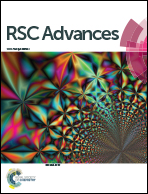‘Turn-on’ coordination based detection of Pd2+ and bioimaging applications†
Abstract
A molecular probe derived by conjugating the metal ion binding dithia-dioxa-aza crown ether with BODIPY, a fluorescent signalling handle, detects Pd2+ with a detection limit (1.18 ppb) complying satisfactorily with the permissible concentration set by WHO in drug chemicals. On the basis of DFT/TD-DFT studies, the ‘turn-on’ behaviour on binding to Pd2+ could be correlated to the restricted photoinduced electron transfer (PET).


 Please wait while we load your content...
Please wait while we load your content...